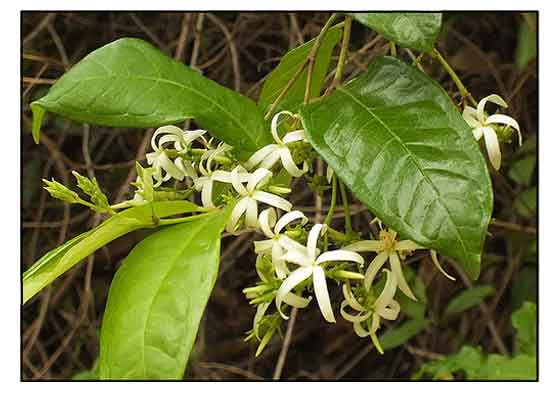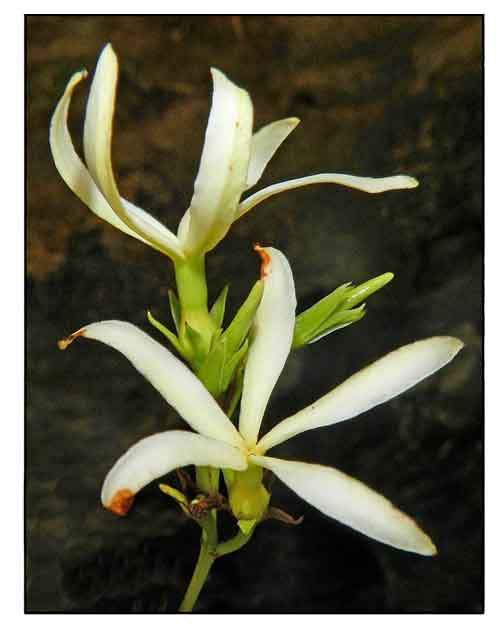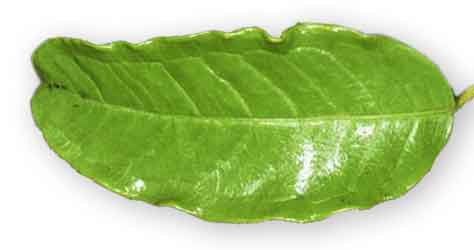
Family • Apocynaceae
Aganosma
Amphineurion marginatum (Roxb.) D.J.Middleton
LONG PETAL AGANOSMA/ COMMON AGANOSMA
Xiang hua teng
| Scientific names | Common names |
| Aganosma acuminata G.Don     | Aganosma (General) |
| Aganosma euloba Miq.    | Common aganosma (Engl.) |
| Aganosma macrocarpa A.DC. Â Â Â | Long-petal aganosma |
| Aganosma marginata (Roxb.) G.Don     | |
| Aganosma velutina A.DC. Â Â Â Â | |
| Amphineurion acuminatum (G.Don) Pichon    | |
| Amphineurion velutinum (A.DC.) Pichon    | |
| Chonemorpha cristata (Roth) G.Don     | |
| Echites acuminatus Roxb. Â Â Â | |
| Echites apoxys Voigt    | |
| Echites cristatus Roth    | |
| Echites marginatus (Roxb.) Mottet   | |
| Echites procumbens Blanco    | |
| Echites repens Blanco    | |
| Holarrhena procumbens (Blanco) Merr.   | |
| Ichnocarpus acuminatus (G.Don) Fern.-Vill. Â Â Â | |
| Ichnocarpus marcrocarpus (A.DC.) Fern.-Vill. Â Â Â | |
| Ichnocarpus marginatus (Roxb.) Mottet   | |
| Ichnocarpus velutinus (A.DC.) Fern.-Vill. Â Â Â | |
| Sindora inermis Merr. is an accepted species. KEW: Plants of the World Online | |
| Other vernacular names |
| CHINA: Xiang hua teng. |
| KHMER: Krallam ' pae, Trallam' pae. |
| MALAY: Ara tanah, Sakat lima, Sekati lima, Akar gerip putih. |
| THAI: Ker sai tan. |
Botany • Long-Petal Aganosma is shrub-like when young with arching stems, climber when conditions suitable. Showy flowers are borne in lax clusters, at branch-ends and in leaf-axils, hairless to sparsely finely velvet-hairy, 4-20 cm long. Flower are white or yellowish, tube 8-10 mm, densely hairy inside; petals very narrowly elliptic, 1.5-2 cm x 2-3.5 mm. Stamens inserted below middle of flower tube. Sepals are near linear, 5-7 mm, finely velvet-hairy outside. Leaf-stalks are about 1 cm; leaf blade oblong, 4.5-12 x 2-4 cm, below velvet-hairy especially along veins, base pointed to rounded, tip tapering or with a tail; lateral veins 12-15 pairs, elevated below. Seedpods are 2, cylindric, 15-40 x about 1 cm. (Flowers of India)
Constituents Properties Availability |
February 2025
![]()
 |
| Â Â Â Â Â Â Â Â Â Â Â Â Â Â Â Â Â Â Â Â Â Â Â Â Â PHOTOS / ILLUSTRATIONS |
| IMAGE SOURCE: Amphineurion marginatum / Len Worthington / CC BY-SA 2.0 / Image modified / Click on image or link to go to source page / Wikipedia |
| OTHER IMAGE SOURCE: Apocynaceae: Amphineurion marginatum / Flowers / Copyright © 2013 by Danilo Tandang (contact: pieter.pelser@canterbury.ac.nz) [ref. DOL75267] / Non-Commercial Use / Image modified / Click on image or link to go to source page b/ Phytoimages.siu.edu |
| OTHER IMAGE SOURCE: Amphineurion marginatum / Forest Herbarium / Leaf / Image modified / Non-commercial use / Image modified / Click on image or link to go to source page / Facebook |
Additional
Sources and Suggested Readings |
• |
DOI: It is not uncommon for links on studies/sources to change. Copying and pasting the information on the search window or using the DOI (if available) will often redirect to the new link page. (Citing and Using a (DOI) Digital Object Identifier) |
| Â Â Â Â Â Â Â Â Â Â Â Â Â Â Â Â Â Â Â Â Â Â Â Â Â Â Â Â Â Â List of Understudied Philippine Medicinal Plants |
| Â Â Â Â Â Â Â Â Â Â Â Â Â Â Â Â Â Â Â Â Â New plant names needed The compilation now numbers over 1,500 medicinal plants. While I believe there are hundreds more that can be added to the collection, they are becoming more difficult to find. If you have a plant to suggest for inclusion, native or introduced, please email the info: scientific name (most helpful), local plant name (if known), any known folkloric medicinal use, and, if possible, a photo. Your help will be greatly appreciated. |
• |
 |




